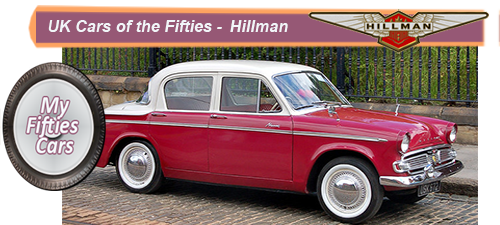 The Hillman Car Company was founded in 1910 by William Hillman in the Midlands city of Coventry.
The Hillman Car Company was founded in 1910 by William Hillman in the Midlands city of Coventry.
Coventry at that time was the UK epicentre of the cycle manufacturing industry.
Initially Hillman, a talented engineer was involved in manufacturing cycles,first forming a partnership with another engineer John Kemp Starley.
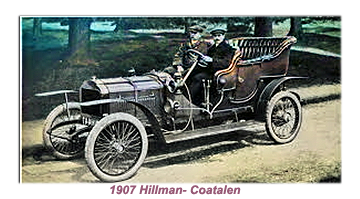 Despite having worked together for years at the Coventry Sewing Machine Company, the partnership did not work out, and the pair soon parted company.
Starley went on to form his own bicycle manufacturing enterprise, which eventually evolved to become the Rover car company.
Despite having worked together for years at the Coventry Sewing Machine Company, the partnership did not work out, and the pair soon parted company.
Starley went on to form his own bicycle manufacturing enterprise, which eventually evolved to become the Rover car company.
Hillman also establishedhis own cycle manufacturing company Auto Machinery, based in the small town of Stoke Aldermoor near Coventry. Auto Machinery was a tremendous success, making a Hillman a considerable fortune.
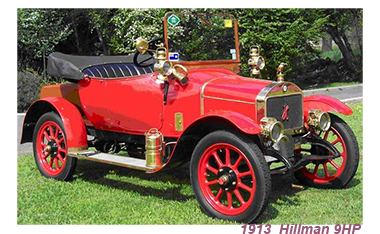 By the turn of the century, it was estimated that Hillman had amassed a personal fortune of around one million pounds, a vast sum of money in these times.
By the turn of the century, it was estimated that Hillman had amassed a personal fortune of around one million pounds, a vast sum of money in these times.
 Ever ambitious, Hillman began to turn his attentions to car manufacturing, investing sum of his fortune in establishing a specialist unit to specialise in car manufacturing. Hillman insisted that his car manufacturing interests would be a separate entity form Auto Machinery, naming his new enterprise, the Hillman Car Company.
Ever ambitious, Hillman began to turn his attentions to car manufacturing, investing sum of his fortune in establishing a specialist unit to specialise in car manufacturing. Hillman insisted that his car manufacturing interests would be a separate entity form Auto Machinery, naming his new enterprise, the Hillman Car Company.
In 1907, Hillman released their first model, a 24HP engined tourer under the title of Hillman-Coatalen, named after Hillman’s French born in house designer Louis Coatalen.
![]()
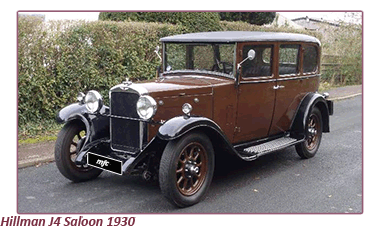
Coatalen did not remain too long with Hillman, leaving abruptly to join the Singer Motor Company,
From then onwards, with his trust in designers with big reputations shattered, Hillman used a series of less skilled designers, which led the company to focus on producing low profile models that did not sell in particularly spectacular quantities.
The Hillman did achieve limited commercial success and positive critical appraisal with their 9HP launched in 1913, which remained in (limited) production throughout the First World War and well into the Twenties.
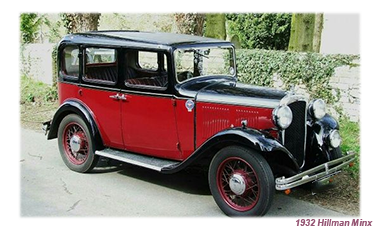 In 1921 William Hillman passed away, and his two sons-in-law , John Black and Maurice Wilks , who had been running the company for him for several years previously took control.
In 1921 William Hillman passed away, and his two sons-in-law , John Black and Maurice Wilks , who had been running the company for him for several years previously took control.
Black and Spencer made a couple of significant moves during the Twenties, first replacing the 9HP in 1926 with an updated 14HP version.
 Their most siignificant move came in 1928, when Black and Wilks decided that there was more safety in numbers, reaching a merger agreement with neighbours, Humber Motors.
Their most siignificant move came in 1928, when Black and Wilks decided that there was more safety in numbers, reaching a merger agreement with neighbours, Humber Motors.
Just four years later both companies became part of the wide-ranging Rootes Group , headed by the hard driving Sir William Rootes, who had major expansion plans based around Humber and Hillman.
Plans that did not appear to include John Black and Maurice Wilks.
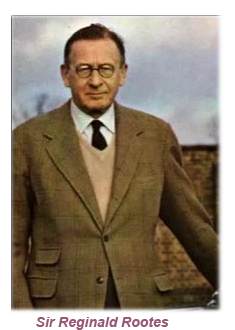
Wilks and Black soon saw the writing on the wall, going on to achieve great success with other companies in the car industry- Black with the Standard Motor Company and Wilks with Rover.
In the years immediately preceding the outbreak of the Second World War as well as directly after, Hillman cars were marketed under several other Rootes marques, with the company feeling the benefits from being under the umbrella of the giant car group.
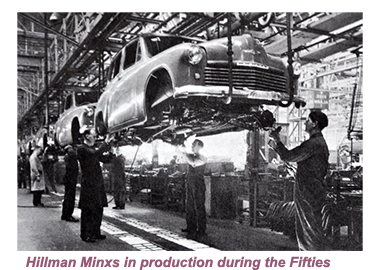 From 1945 private car assembly for all of the Rootes Group was concentrated into a modern, ex-"shadow factory" at Ryton-on-Dunsmore, close to Coventry.
From 1945 private car assembly for all of the Rootes Group was concentrated into a modern, ex-"shadow factory" at Ryton-on-Dunsmore, close to Coventry.
Hillman focused on building the small-medium Minx models, with one type succeeding another, with similar models using the same body marketed under the Rootes owed Singer and Sunbeam labels.
As the principal Rootes Group 'marque' going into the Sixties, Hillman focused their attentions on the rapidly growing medium-capacity saloon car market.
![]()
Hillman's choice of vehicles was, as ever, thin on the ground, based on a variety of Minx saloon variants as well as the Husky Estate.
In 1960 the current version of the Minx was the Mark IIIA four-door saloon, with its distinctive wrap-around rear screen and slight turn-over on the small tail fins.
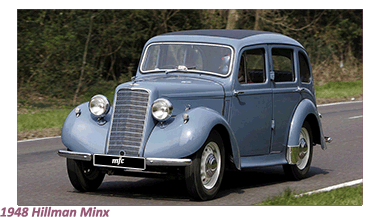 The Minx IIIA was powered by a 1494-cc four-cylinder overhead valve engine, which with its Zenith W19 carburettor was capable of generating a healthy 56.5 bhp gross.
The Minx IIIA was powered by a 1494-cc four-cylinder overhead valve engine, which with its Zenith W19 carburettor was capable of generating a healthy 56.5 bhp gross.
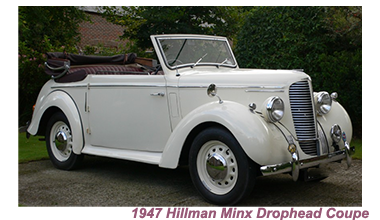 Hillman tended to offer a wide variety of permutations on the same theme, and this was the case with the IIIA Minx that came as a Standard, 'Special,' De Luxe in saloon, convertible and estate car versions.
Hillman tended to offer a wide variety of permutations on the same theme, and this was the case with the IIIA Minx that came as a Standard, 'Special,' De Luxe in saloon, convertible and estate car versions.
In the first twenty post-war years, the long-running Hillman Minx used only three basic body shells and two types of engine.
Even early on in the Sixties, despite demand for new cars reaching unprecedented peaks, it was becoming evident that demand for cars produced the Rootes Group was lagging behind the field in the face of strong competition from Ford UK, Triumph and Vauxhall.
![]()
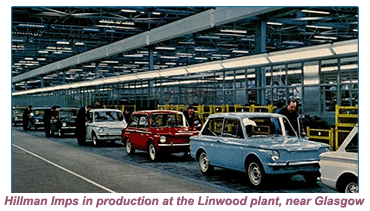 Hillman's situation was not helped by a long and crippling strike the group at the group’s body plant in 1962 that paralysed production with a terrible knock-on effect on the group finances.
Hillman's situation was not helped by a long and crippling strike the group at the group’s body plant in 1962 that paralysed production with a terrible knock-on effect on the group finances.
At that point, the Rootes Group were in the advanced stages of building a massive new plant in Paisley, Scotland to produce the Hillman Imp.
The Imp was the Rootes Group’s version of the Super Mini, which they hoped would help to restore their fortunes.
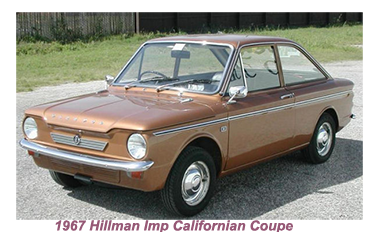 As many industry observers predicted, the vast investment involved in establishing the plant and the lack of income caused by the strike turned out to be too much of a burden to bear.
As many industry observers predicted, the vast investment involved in establishing the plant and the lack of income caused by the strike turned out to be too much of a burden to bear.
In financial mel tdown Rootes reached out to the massive Chrysler group who took a significant (though not controlling) financial stake to Chrysler of the USA.
tdown Rootes reached out to the massive Chrysler group who took a significant (though not controlling) financial stake to Chrysler of the USA.
Before the takeover became final, Hillman succeeded in developing two new family car ranges — the Hunter and Minx of 1966/67, and the all-new Avenger of 1970.
Hillman as a brand would then carry on as Chrysler UK's entry-level marque until 1977 when the Chrysler name took precedence with the name Hillman disappearing entirely.
 <
<

